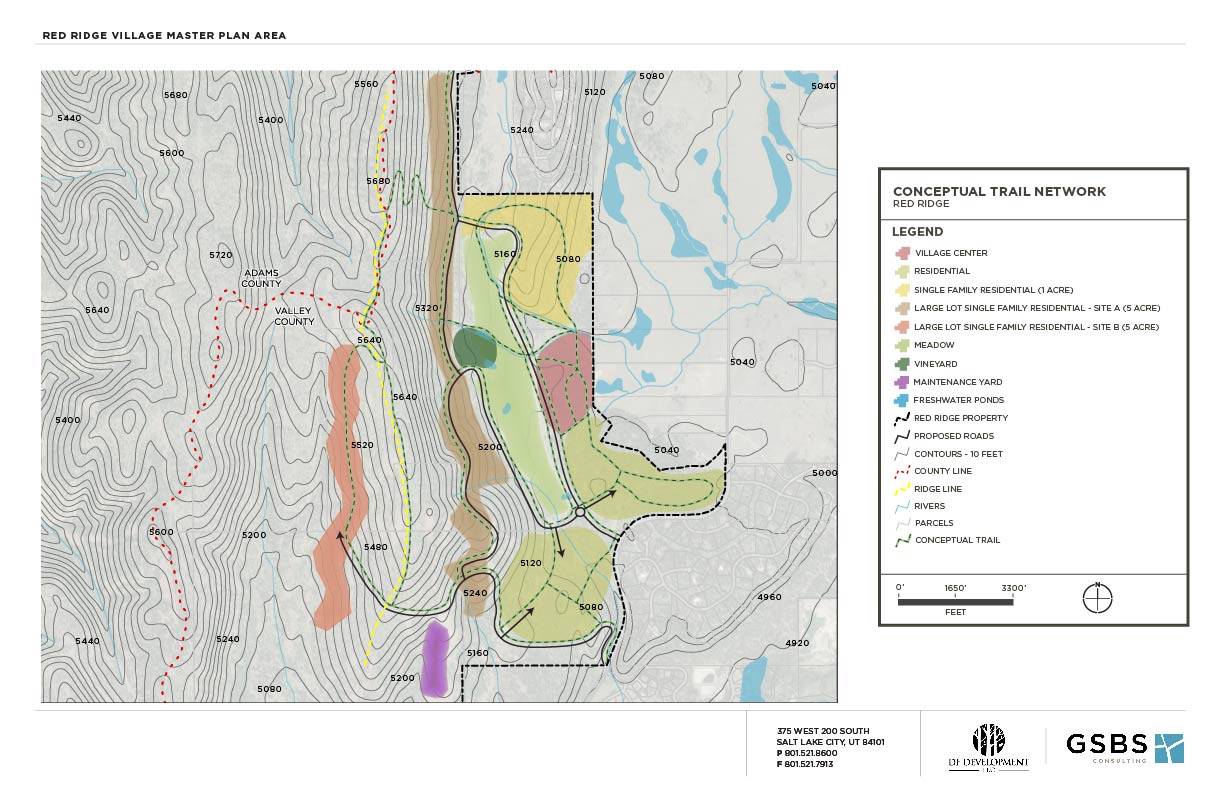Red Ridge Village
Home – Red Ridge Village
The Red Ridge development exemplifies a forward-thinking approach to sustainable housing, integrating environmental responsibility with social inclusivity. With over 22,000 acres dedicated to conservation, this project prioritizes preserving Idaho’s natural beauty while fostering diverse, vibrant communities. With a range of housing options, Red Ridge Village blends comfort and sustainability to create a community where residents can enjoy modern living surrounded by nature.
Beyond housing, Red Ridge supports a holistic vision of community and sustainability. The plan includes public trail systems tied into existing networks, conserving wildlife habitats, and ensuring minimal strain on local resources with robust infrastructure planning. By addressing key concerns such as water rights, traffic impacts, and fire management, the development demonstrates a commitment to long-term harmony with its surroundings. Red Ridge isn’t just a development project—it’s a model for inclusive, resilient, and sustainable communities where people of all backgrounds can thrive in a preserved and protected natural landscape.
- Frequently Asked Questions
No, the property purchased by Dan and Farris Wilks was private land. While previous owners may have allowed public use, the land was never public. Unfortunately, some individuals mistreated and abused the property under the assumption it was public, leading to its degradation. To protect and restore the land, the Wilks family gated it off, allowing it to heal and flourish.
Q: What is the Wilks Family’s Connection to Idaho?
A: The Wilks come from a small, close-knit community, much like McCall, Idaho. They’ve raised their families in similar small-town environments and have a deep appreciation for the values these communities represent.
The Wilks family owns land in Idaho, conducts business here, employs Idahoans, and contributes to the state economy.
In addition, the family actively supports local schools and community events, demonstrating their commitment to being positive and engaged members of the Idaho community.
Q: What has been done to improve the land and wildlife?
A: The property was overharvested in both timber and wildlife prior to the Wilks family’s acquisition. Since then, DF Development has prioritized improving forest density, restoring the ecosystem, and creating an environment where wildlife can thrive. Our efforts reflect a deep commitment to caring for the land and its natural inhabitants. As Idahoans, our intent is to work with the community to care for and conserve Idaho’s natural resources and beauty.
Q: Have the Wilks family bought public land and blocked access?
A: No. The land purchased was private, not public. The decision to gate the property and limit access was made due to issues caused by some individuals who abused the land. These activities included excessive illegal dumping, overhunting, and failure to adhere to the ‘leave no trace’ policy.
DF Development encourages responsible land use and preservation and hopes the community will focus their frustration on those who misused the land, not on efforts to protect it.
Q: Will there be public trail systems?
A: Yes. Trail systems on the east side of Red Ridge will be public and connected to existing networks. We will continue to work with local recreation groups that share a similar respect and care for the land.
View the conceptual trails map by clicking HERE or the button above on the page.
Q: Will this development ruin the Idaho wilderness?
A: No. The plan sets aside over 22,000 acres out of 30,000 for preservation and conservation, with over 13,000 acres bordering forest service land to create a large protected ecosystem.
Q: Are the development practices displacing wildlife or reducing access to nature?
A: The plan includes guidance for the HOA on wildlife habitat management, following best practices from Idaho Fish & Game. Additionally, the plan supports elk habitat preservation and a conservation meadow based on studies done on elk migration patterns. Additionally, roads and utility infrastructure will be restricted in these conservation areas.
Q: What does “elk habitat” mean in this context?
A: The elk habitat maps, provided by Idaho Fish & Game, identify areas in Red Ridge used as summer and winter elk ranges.
Q: Will this development address the local community housing shortage?
A: The plan includes a mix of housing types and price points to accommodate various household needs, helping to maintain affordability. Our intent is to cover the needs beyond the development.
Q: Is there enough demand for 1,100 homes in the area?
A: Yes. The development will occur over a decade, offering a variety of housing types. Market analysis indicates sufficient demand over the next 10 years.
Q: How will traffic increases be managed?
A: A comprehensive traffic impact study was conducted to identify necessary improvements. These improvements address both current challenges on the roadways and future traffic impacts, ensuring a well-managed solution for the community.
Q: Will the roads be public or private?
A: Internal roads will be private and maintained through the HOA. There will be public roads designated in the public areas.
Q: Where will power come from?
A: DF Development will collaborate with Idaho Power and is exploring additional options, which will be resolved before Phase 1 approval. We are considering and reviewing additional power sources and infrastructure.
Q: How will sewer and water needs be addressed?
A: Community housing and medium-density areas will have a dedicated sewer and water system. Depending on location, estate lots will use wells and improved or enhanced septic systems.
Q: How will fire management be handled?
A: A detailed plan is in development for each phase to address fire risks in the wildland-urban interface. Fire management will exist through partnerships with public and private organizations to place emphasis on fuel management, fire lines, and fire breaks.
Q: How will Red Ridge Village balance preserving its natural aesthetic appeal while accommodating community growth and development?
A: Idaho’s natural beauty is a treasure worth preserving, even as the state experiences rapid population growth. We believe in striking a harmonious balance between embracing this growth and protecting the natural aesthetics that make Idaho special. Our vision is to create a development that seamlessly blends into the surrounding scenery, complementing rather than detracting from it.
It is our intent to preserve Idaho’s wilderness and foster thoughtful growth with respect to the land, by utilizing modern construction practices, careful planning, and a commitment to design integrity.
CONTACT US
To Learn More
Discover how Red Ridge is redefining sustainable community living—where environmental preservation meets inclusive housing opportunities. Contact us today to learn more about our vision and how you can be part of this forward-thinking development!

